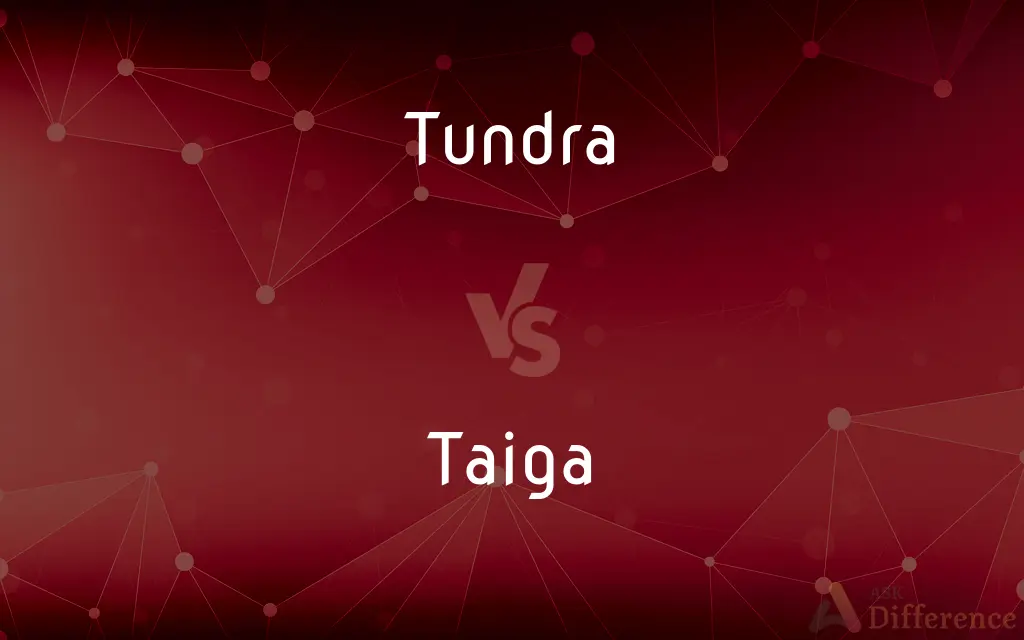Tundra vs. Taiga — What's the Difference?
By Tayyaba Rehman & Fiza Rafique — Updated on September 16, 2023
"Tundra" refers to a cold, barren, treeless region found in Arctic and subarctic areas. "Taiga" is a subarctic biome characterized by coniferous forests.

Difference Between Tundra and Taiga
Table of Contents
ADVERTISEMENT
Key Differences
"Tundra" and "Taiga" both represent specific types of biomes, but they vary in temperature, vegetation, and geographical distribution. Tundra is typically found in extremely cold environments like the Arctic, where it's too cold for trees to grow. Taiga, however, exists in subarctic regions and consists mostly of coniferous trees like spruce and pine.
The soil in the "Tundra" is usually frozen and is known as permafrost, making it difficult for many plants to take root. "Taiga" soil is not permafrost and can support a wider variety of plant life. Tundra may host some low-growing vegetation like mosses and lichens, while the taiga can sustain more diverse flora including shrubs and flowering plants.
In terms of fauna, "Tundra" is relatively less diverse due to its harsh conditions. Animals like the Arctic fox and polar bears are commonly found there. "Taiga" has a broader range of wildlife, including mammals like moose and brown bears and various bird species.
From a grammatical standpoint, both "Tundra" and "Taiga" are primarily used as nouns. They don't function as verbs, and their adjectival forms—tundra-like and taiga-like—are rarely used but understood in context. These terms are often capitalized when referring to specific regions, like the Arctic Tundra or the Siberian Taiga.
Comparison Chart
Temperature
Extremely cold
Cold, but milder than tundra
ADVERTISEMENT
Vegetation
Mostly absent or low-growing
Mostly coniferous trees
Soil
Permafrost
Not permafrost
Animal Diversity
Less diverse
More diverse
Grammatical Use
Primarily a noun
Primarily a noun
Compare with Definitions
Tundra
An area too cold for most trees to grow.
You won't find tall trees in the tundra.
Taiga
A subarctic forest dominated by coniferous trees.
The taiga is filled with pine and spruce trees.
Tundra
A treeless, barren land in Arctic regions.
The Arctic tundra is home to polar bears.
Taiga
An area with soil that can support more diverse plant life.
Unlike the tundra, the taiga's soil is not permanently frozen.
Tundra
An ecosystem dominated by lichens and mosses.
Mosses are one of the few plants that can survive in the tundra.
Taiga
A biome with cold winters and mild summers.
Taiga regions experience seasonal temperature variations.
Tundra
A cold biome with permafrost soil.
The tundra's permafrost prevents many plants from taking root.
Taiga
A region rich in biodiversity compared to tundra.
The taiga is home to a variety of bird species.
Tundra
A region with low biodiversity due to harsh conditions.
Animal species in the tundra have adapted to extreme cold.
Taiga
An ecosystem that acts as a transitional zone between tundra and temperate forests.
The taiga lies to the south of the tundra.
Tundra
In physical geography, tundra () is a type of biome where the tree growth is hindered by low temperatures and short growing seasons. The term tundra comes through Russian тундра (tundra) from the Kildin Sámi word тӯндар (tūndâr) meaning "uplands", "treeless mountain tract".
Taiga
Taiga (; Russian: тайга́, IPA: [tɐjˈɡa]; relates to Mongolic and Turkic languages), generally referred to in North America as a boreal forest or snow forest, is a biome characterized by coniferous forests consisting mostly of pines, spruces, and larches. The taiga or boreal forest has been called the world's largest land biome.
Tundra
A treeless area beyond the timberline in high-latitude regions, having a permanently frozen subsoil and supporting low-growing vegetation such as lichens, mosses, and shrubs.
Taiga
A subarctic area of northern Eurasia and North America located just south of the tundra and covered largely with coniferous forests dominated by firs and spruces.
Tundra
A similar area found at high elevations.
Taiga
A subarctic zone of evergreen coniferous forests situated south of the tundras and north of the steppes in the Northern Hemisphere.
Tundra
A flat and treeless Arctic biome.
Tundra
One of the level or undulating treeless plains characteristic of northern arctic regions in both hemispheres; the term is most commony associated with the arctic plains of Siberia. The tundras mark the limit of arborescent vegetation; they consist of black mucky soil with a permanently frozen subsoil, but support a dense growth of mosses and lichens, and dwarf herbs and shrubs, often showy-flowered.
Tundra
A vast treeless plain in the arctic regions between the ice cap and the tree line
Common Curiosities
Does Taiga have trees?
Yes, the taiga is primarily composed of coniferous trees.
Is Tundra colder than Taiga?
Yes, the tundra is generally colder than the taiga.
What is Tundra?
Tundra is a cold, barren, and usually treeless region.
What is Taiga?
Taiga is a cold biome characterized by coniferous forests.
Is the soil in Tundra frozen?
Yes, the tundra has permafrost, or permanently frozen soil.
Is Taiga a noun?
Yes, taiga is primarily used as a noun.
Where is Taiga located?
Taiga is generally found in subarctic regions.
What animals live in Taiga?
Animals like moose, brown bears, and various bird species are found in the taiga.
Does Taiga have permafrost?
No, the soil in taiga is not permafrost.
Is Tundra a noun?
Yes, tundra is primarily used as a noun.
What plants grow in Tundra?
Mostly low-growing plants like mosses and lichens.
What plants grow in Taiga?
Mainly coniferous trees like pine and spruce, along with some shrubs and flowering plants.
Can Tundra support diverse wildlife?
Tundra has less biodiversity compared to taiga due to its harsh conditions.
Can Taiga and Tundra exist near each other?
Yes, taiga often acts as a transitional zone between tundra and temperate forests.
Where is Tundra located?
Tundra is usually found in Arctic and subarctic regions.
Share Your Discovery

Previous Comparison
Projection vs. Prediction
Next Comparison
Leverage vs. PowerAuthor Spotlight
Written by
Tayyaba RehmanTayyaba Rehman is a distinguished writer, currently serving as a primary contributor to askdifference.com. As a researcher in semantics and etymology, Tayyaba's passion for the complexity of languages and their distinctions has found a perfect home on the platform. Tayyaba delves into the intricacies of language, distinguishing between commonly confused words and phrases, thereby providing clarity for readers worldwide.
Co-written by
Fiza RafiqueFiza Rafique is a skilled content writer at AskDifference.com, where she meticulously refines and enhances written pieces. Drawing from her vast editorial expertise, Fiza ensures clarity, accuracy, and precision in every article. Passionate about language, she continually seeks to elevate the quality of content for readers worldwide.
















































